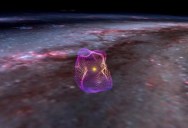Astronomers Unveil 3D Map of Magnetic Fields in our Solar System’s “Local Bubble”
Astronomically speaking, we all live in a bubble, literally. Our Solar System sits inside what’s known as the Local Bubble, an area within the Milky Way galaxy that is about 1,000 light-years across and filled with hot gas atoms.
That’s why it’s so cool that astronomers have recently unveiled a new 3D map to better visualize the Local Bubble and other superbubbles.

Photo Credit: IFLSCIENCE
While Superbubbles in the galaxy are not rare, our knowledge about them is limited. We know these cavities are left behind by supernova explosions and stellar winds strip the superbubble’s surface of other dust or gas, but the remaining material is dense enough to prompt star formations.
Researchers created a magnetic map of the Local Bubble, presented at the American Astronomical Society’s 241st meeting, in an attempt to better understand the mechanics that drive the Local Bubble and other superbubbles, including the role magnetic fields play in these formations.
“Putting together this 3D map of the Local Bubble will help us examine superbubbles in new ways,” Theo O’Neill of the Center for Astrophysics | Harvard & Smithsonian, said in a statement.
The large but thin magnetic fields that stretch over thousands of light-years across the superbubbles have been difficult to map. That’s partly because we can’t see magnetic fields directly, but rather through the polarization of light.
The team used information from the Gaia observatory and the Planck Space Telescope to help create their 3D map. The team hopes the mapping will be able to test the assumption that the dust and magnetic fields that produce the polarization are concentrated on the bubble’s surface and that their work will prompt similar studies.

Sign up to get our BEST stories of the week straight to your inbox.




